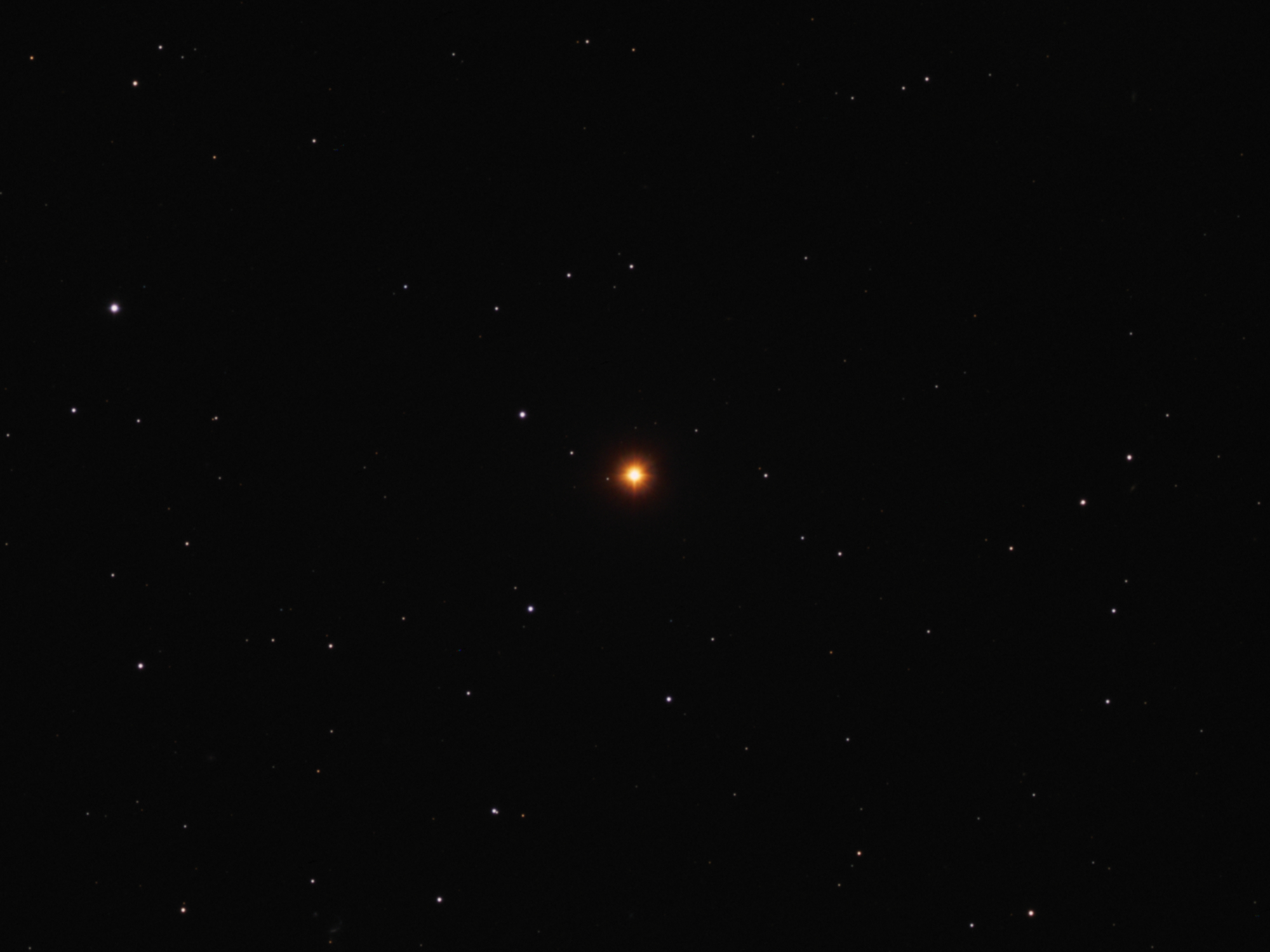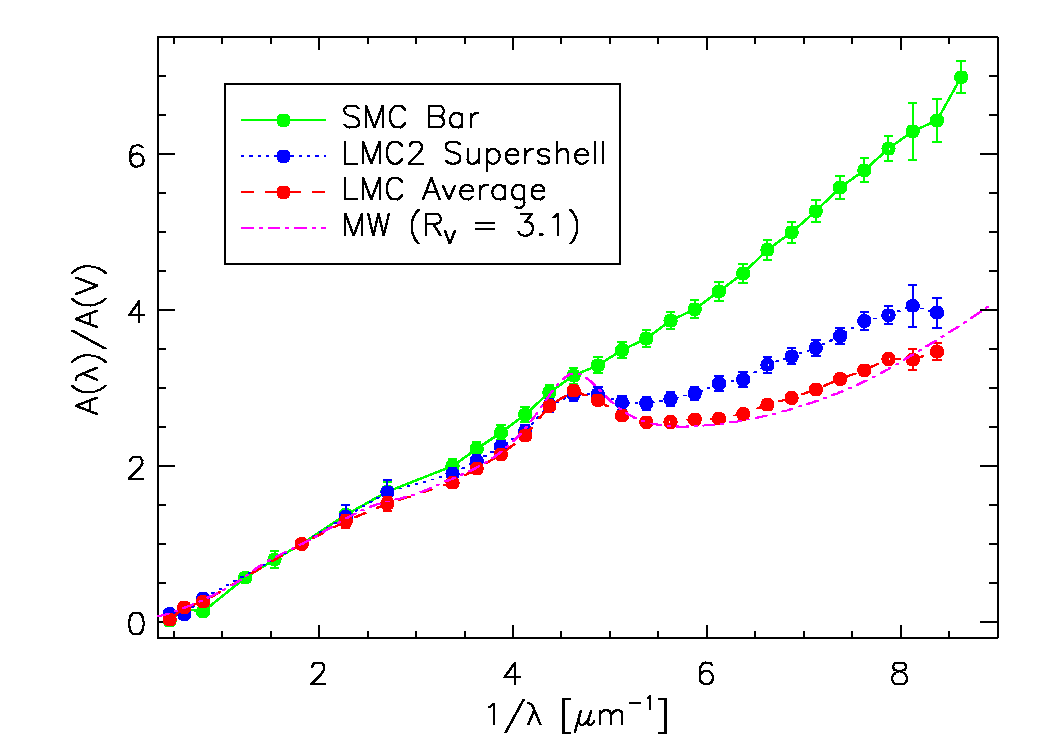|
Color Index
In astronomy, the color index is a simple numerical expression that determines the color of an object, which in the case of a star gives its temperature. The lower the color index, the more blue (or hotter) the object is. Conversely, the larger the color index, the more red (or cooler) the object is. This is a consequence of the logarithmic magnitude scale, in which brighter objects have smaller (more negative) magnitudes than dimmer ones. For comparison, the whitish Sun has a B−V index of , whereas the bluish Rigel has a B−V of −0.03 (its B magnitude is 0.09 and its V magnitude is 0.12, B−V = −0.03). Traditionally, the color index uses Vega as a zero point. The blue supergiant Theta Muscae has one of the lowest B−V indices at −0.41, while the red giant and carbon star R Leporis has one of the largest, at +5.74. To measure the index, one observes the magnitude of an object successively through two different filters, such as U and B, or B and V, where U is ... [...More Info...] [...Related Items...] OR: [Wikipedia] [Google] [Baidu] |
Stellar Classification
In astronomy, stellar classification is the classification of stars based on their stellar spectrum, spectral characteristics. Electromagnetic radiation from the star is analyzed by splitting it with a Prism (optics), prism or diffraction grating into a spectrum exhibiting the Continuum (spectrum), rainbow of colors interspersed with spectral lines. Each line indicates a particular chemical element or molecule, with the line strength indicating the abundance of that element. The strengths of the different spectral lines vary mainly due to the temperature of the photosphere, although in some cases there are true abundance differences. The ''spectral class'' of a star is a short code primarily summarizing the ionization state, giving an objective measure of the photosphere's temperature. Most stars are currently classified under the Morgan–Keenan (MK) system using the letters ''O'', ''B'', ''A'', ''F'', ''G'', ''K'', and ''M'', a sequence from the hottest (''O'' type) to the cool ... [...More Info...] [...Related Items...] OR: [Wikipedia] [Google] [Baidu] |
Carbon Star
A carbon star (C-type star) is typically an asymptotic giant branch star, a luminous red giant, whose Stellar atmosphere, atmosphere contains more carbon than oxygen. The two elements combine in the upper layers of the star, forming carbon monoxide, which consumes most of the oxygen in the atmosphere, leaving carbon atoms free to form other carbon compounds, giving the star a "sooty" atmosphere and a strikingly Ruby (color), ruby red appearance. There are also some dwarf and supergiant carbon stars, with the more common giant stars sometimes being called classical carbon stars to distinguish them. In most stars (such as the Sun), the atmosphere is richer in oxygen than carbon. Ordinary stars not exhibiting the characteristics of carbon stars but cool enough to form carbon monoxide are therefore called oxygen-rich stars. Carbon stars have quite distinctive stellar classification, spectral characteristics, and they were first recognized by their spectra by Angelo Secchi in the 186 ... [...More Info...] [...Related Items...] OR: [Wikipedia] [Google] [Baidu] |
UBVRI
__NOTOC__ The UBV photometric system (from ''Ultraviolet, Blue, Visual''), also called the Johnson system (or Johnson-Morgan system), is a photometric system usually employed for classifying stars according to their colors. It was the first standardized photometric system. The apparent magnitudes of stars in the system are often used to determine the color indices B−V and U−B, the difference between the B and V magnitudes and the U and B magnitudes respectively. The system is defined using a set of color optical filters in combination with an RMA 1P21 photomultiplier tube. The choice of colors on the blue end of the spectrum was assisted by the bias that photographic film has for those colors. It was introduced in the 1950s by American astronomers Harold Lester Johnson and William Wilson Morgan. A telescope and the telescope at McDonald Observatory were used to define the system. The filters that Johnson and Morgan used were Corning 9 863 for U and 3 384 for V. The ... [...More Info...] [...Related Items...] OR: [Wikipedia] [Google] [Baidu] |
Astronomer
An astronomer is a scientist in the field of astronomy who focuses on a specific question or field outside the scope of Earth. Astronomers observe astronomical objects, such as stars, planets, natural satellite, moons, comets and galaxy, galaxies – in either observational astronomy, observational (by analyzing the data) or theoretical astronomy. Examples of topics or fields astronomers study include planetary science, Sun, solar astronomy, the Star formation, origin or stellar evolution, evolution of stars, or the galaxy formation and evolution, formation of galaxies. A related but distinct subject is physical cosmology, which studies the Universe as a whole. Types Astronomers typically fall under either of two main types: observational astronomy, observational and theoretical astronomy, theoretical. Observational astronomers make direct observations of Astronomical object, celestial objects and analyze the data. In contrast, theoretical astronomers create and investigate Con ... [...More Info...] [...Related Items...] OR: [Wikipedia] [Google] [Baidu] |
Passband
A passband is the range of frequency, frequencies or wavelengths that can pass through a Filter (signal processing), filter. For example, a radio receiver contains a bandpass filter to select the frequency of the desired radio signal out of all the radio waves picked up by its antenna. The passband of a receiver is the range of frequencies it can receive when it is tuned into the desired frequency as in a radio station or television channel. A band-pass filter, bandpass-filtered signal (that is, a signal with energy only in a passband), is known as a bandpass signal, in contrast to a baseband signal. The bandpass filter usually has two stopband, band-stop filters. Filters In telecommunications, optics, and acoustics, a passband (a band-pass filtered signal) is the portion of the frequency spectrum that is transmitted (with minimum relative loss or maximum relative Gain (electronics), gain) by some filtering device. In other words, it is a ''band'' of frequencies which ''pa ... [...More Info...] [...Related Items...] OR: [Wikipedia] [Google] [Baidu] |
Interstellar Reddening
In astronomy, extinction is the absorption and scattering of electromagnetic radiation by dust and gas between an emitting astronomical object and the observer. Interstellar extinction was first documented as such in 1930 by Robert Julius Trumpler. However, its effects had been noted in 1847 by Friedrich Georg Wilhelm von Struve, and its effect on the colors of stars had been observed by a number of individuals who did not connect it with the general presence of galactic dust. For stars lying near the plane of the Milky Way which are within a few thousand parsecs of the Earth, extinction in the visual band of frequencies (photometric system) is roughly 1.8 magnitudes per kiloparsec. For Earth-bound observers, extinction arises both from the interstellar medium and the Earth's atmosphere; it may also arise from circumstellar dust around an observed object. Strong extinction in Earth's atmosphere of some wavelength regions (such as X-ray, ultraviolet, and infrared) is ... [...More Info...] [...Related Items...] OR: [Wikipedia] [Google] [Baidu] |
Extinction (astronomy)
In astronomy, extinction is the absorption (electromagnetic radiation), absorption and light scattering, scattering of electromagnetic radiation by dust and gas between an emitting astronomical object and the observation, observer. Interstellar extinction was first documented as such in 1930 by Robert Julius Trumpler. However, its effects had been noted in 1847 by Friedrich Georg Wilhelm von Struve, and its effect on the colors of stars had been observed by a number of individuals who did not connect it with the general presence of Cosmic dust, galactic dust. For stars lying near the plane of the Milky Way which are within a few thousand parsecs of the Earth, extinction in the visual band of frequencies (photometric system) is roughly 1.8 Magnitude (astronomy), magnitudes per kiloparsec. For Observatory#Ground-based_observatories, Earth-bound observers, extinction arises both from the interstellar medium and the Atmosphere of Earth, Earth's atmosphere; it may also arise fro ... [...More Info...] [...Related Items...] OR: [Wikipedia] [Google] [Baidu] |
Black Body
A black body or blackbody is an idealized physical body that absorbs all incident electromagnetic radiation, regardless of frequency or angle of incidence. The radiation emitted by a black body in thermal equilibrium with its environment is called ''black-body radiation''. The name "black body" is given because it absorbs all colors of light. In contrast, a white body is one with a "rough surface that reflects all incident rays completely and uniformly in all directions." A black body in thermal equilibrium (that is, at a constant temperature) emits electromagnetic black-body radiation. The radiation is emitted according to Planck's law, meaning that it has a spectrum that is determined by the temperature alone (see figure at right), not by the body's shape or composition. An ideal black body in thermal equilibrium has two main properties: #It is an ideal emitter: at every frequency, it emits as much or more thermal radiative energy as any other body at the same temperature. ... [...More Info...] [...Related Items...] OR: [Wikipedia] [Google] [Baidu] |
Photometric System
In astronomy, a photometric system is a set of well-defined passbands (or optical filters), with a known sensitivity to incident radiation. The sensitivity usually depends on the optical system, detectors and filters used. For each photometric system a set of primary standard stars is provided. A commonly adopted standardized photometric system is the Johnson-Morgan or UBV photometric system (1953). At present, there are more than 200 photometric systems. Photometric systems are usually characterized according to the widths of their passbands: * broadband (passbands wider than 30 nm, of which the most widely used is Johnson-Morgan UBV system) * intermediate band (passbands between 10 and 30 nm wide) * narrow band (passbands less than 10 nm wide) Photometric letters Each letter designates a section of light of the electromagnetic spectrum; these cover well the consecutive major groups, near-ultraviolet (NUV), visible light (centered on the V band), near-infra ... [...More Info...] [...Related Items...] OR: [Wikipedia] [Google] [Baidu] |
UBV System
__NOTOC__ The UBV photometric system (from ''Ultraviolet, Blue, Visual''), also called the Johnson system (or Johnson-Morgan system), is a photometric system usually employed for classifying stars according to their colors. It was the first standardized photometric system. The apparent magnitudes of stars in the system are often used to determine the color indices B−V and U−B, the difference between the B and V magnitudes and the U and B magnitudes respectively. The system is defined using a set of color optical filters in combination with an RMA 1P21 photomultiplier tube. The choice of colors on the blue end of the spectrum was assisted by the bias that photographic film has for those colors. It was introduced in the 1950s by American astronomers Harold Lester Johnson and William Wilson Morgan. A telescope and the telescope at McDonald Observatory were used to define the system. The filters that Johnson and Morgan used were Corning 9 863 for U and 3 384 for V. The ... [...More Info...] [...Related Items...] OR: [Wikipedia] [Google] [Baidu] |
Ultraviolet
Ultraviolet radiation, also known as simply UV, is electromagnetic radiation of wavelengths of 10–400 nanometers, shorter than that of visible light, but longer than X-rays. UV radiation is present in sunlight and constitutes about 10% of the total electromagnetic radiation output from the Sun. It is also produced by electric arcs, Cherenkov radiation, and specialized lights, such as mercury-vapor lamps, tanning lamps, and black lights. The photons of ultraviolet have greater energy than those of visible light, from about 3.1 to 12 electron volts, around the minimum energy required to ionize atoms. Although long-wavelength ultraviolet is not considered an ionizing radiation because its photons lack sufficient energy, it can induce chemical reactions and cause many substances to glow or fluoresce. Many practical applications, including chemical and biological effects, are derived from the way that UV radiation can interact with organic molecules. The ... [...More Info...] [...Related Items...] OR: [Wikipedia] [Google] [Baidu] |






